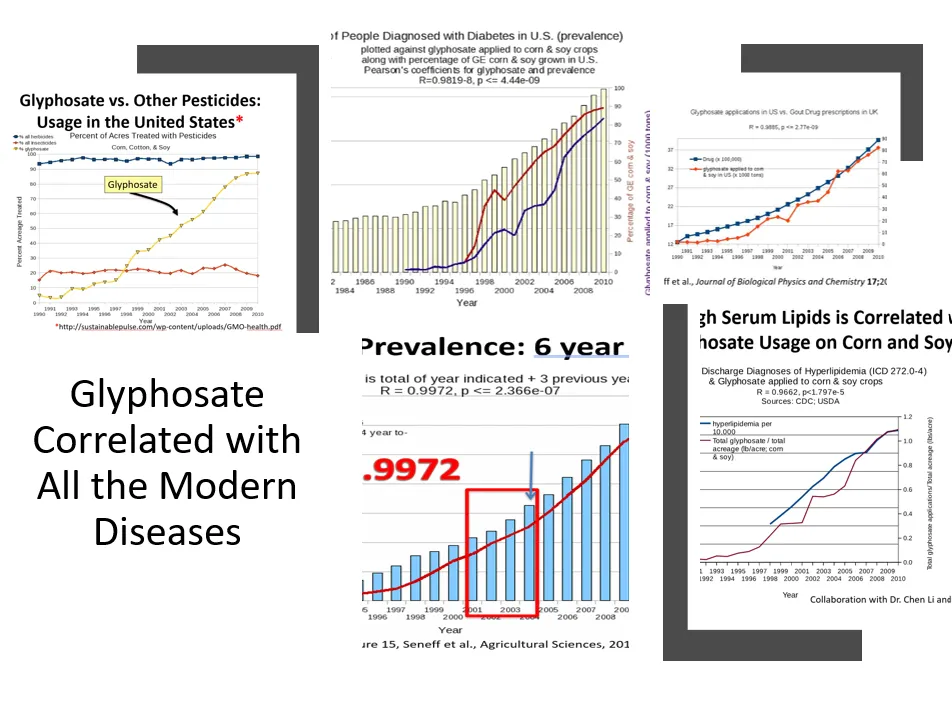The Link Between All the Modern Diseases: Diabetes, ADHD, Autism Spectrum Disorders, and Environmental Toxins
II was diagnosed with inattentive-type ADHD and Type 1 Diabetes within a few years of each other. I believe my sensitivity to a toxic cultural, emotional, and family environment played a role in these diagnoses. Growing up, I felt distressed by the pervasive unhappiness around me, constantly wondering what was wrong and how to help, yet I withdrew into my animal friends and projects. My body might have been trying to signal me, but I wasn't paying attention. This set the stage for my pancreas to fail during a period of intense stress the summer before my 17th year at a camp for gifted kids. By fall, I exhibited all the symptoms of diabetes and received my diagnosis.
The Link Between Disease and Glyphosate
Research indicates a connection between diabetes and ADHD, both of which may be influenced by environmental toxins such as herbicides. Autism spectrum disorders (ASD) are associated with immune system dysfunction, including neuroinflammation, increased autoantibodies, and irregularities in immune cells, cytokines, and immunoglobulins.
According to a 2023 Healthline article, individuals with autism have a 57% higher risk of developing diabetes compared to those without autism. The risk is 64% higher for type 1 diabetes and 146% higher for type 2 diabetes.
Dr. Zach Bush, a triple board-certified physician specializing in Internal Medicine, Endocrinology and Metabolism, and Hospice and Palliative care, argues that the molecular cause for these conditions is linked. Both Type 1 Diabetes and autism spectrum disorders involve the destruction of insulin-producing beta cells (typically through autoimmune mechanisms) and glyphosate exposure.
The Role of Glyphosate
Glyphosate is a widely used herbicide that has been shown to disrupt endocrine function negatively. Although studies demonstrating glyphosate's diabetogenic potential on skeletal muscle and the endocrine system are limited, the herbicide's influence on chronic diseases such as cancer, diabetes, obesity, asthma, and infertility is well-documented. Glyphosate, applied at a rate of 0.75 pounds of acid equivalent per acre, has a half-life of 7 to 60 days and contaminates much of our food and groundwater. The rising incidence of diabetes and autism correlates strongly with the increased use of glyphosate.
Other Endocrine Disruptors
While the correlation between glyphosate and these diseases is strong, other environmental toxins also play a role. These include:
- BPA (Bisphenol-A) and phthalates found in plastics
- Dioxins, byproducts of smelting, paper bleaching, and herbicide and pesticide manufacture
- Atrazine and polychlorinated biphenyls (PCBs), used in electrical equipment, coatings, inks, adhesives, flame-retardants, and paints
Related details about the Biology of Disease Glyphosphate and Modern Diseases - and Suggestions to Counter the Rise of Modern Diseases
Summary of Key Points
- Impact of Glyphosate:
- Glyphosate disrupts critical biological processes, including sulfate synthesis, gut microbiome balance, and essential mineral absorption.
- It is linked to various modern diseases, including autism, diabetes, cardiovascular diseases, and cancer.
- Sulfate Deficiency:
- Essential for detoxification, cellular function, and maintaining gut lining integrity.
- Deficiencies can lead to neurological disorders, stunted growth, reproductive issues, and metabolic problems.
- Gut Health:
- A healthy gut microbiome is crucial for overall health.
- Glyphosate disrupts beneficial gut bacteria, leading to overgrowth of harmful bacteria and gut inflammation.
- Nutrient and Mineral Disruptions:
- Glyphosate chelates essential minerals (iron, zinc, cobalt) and disrupts synthesis of amino acids and vitamins, leading to various deficiencies.
- Inflammation and Oxidative Stress:
- Chronic inflammation and oxidative stress are linked to many modern diseases.
- Supporting the body’s natural detoxification and antioxidant systems is critical.
- Curcumin and Glucosinolates:
- Curcumin (found in turmeric) has anti-inflammatory, anticancer, and antidiabetic properties.
- Glucosinolates (found in cruciferous vegetables) contribute to cancer prevention and overall health.
- Lifestyle and Dietary Adjustments:
- A diet rich in organic whole foods, sulfur-containing foods, and polyphenols.
- Regular sunlight exposure to boost vitamin D and cholesterol sulfate production.
- Use of probiotics to support gut health.
- Detoxification Strategies:
- Activated charcoal, bentonite clay, humic and fulvic acids, and sauerkraut to reduce glyphosate toxicity.
List of Suggestions
- Activated charcoal, bentonite clay, humic and fulvic acids, and sauerkraut to reduce glyphosate toxicity.
- Reduce Glyphosate Exposure:
- Choose organic foods to minimize glyphosate intake.
- Advocate for reduced use of herbicides in agriculture.
- Support Gut Health:
- Incorporate probiotics and prebiotics into your diet to restore beneficial bacteria.
- Avoid antibiotics and other medications that can disrupt gut microbiome balance.
- Increase Sulfur Intake:
- Eat sulfur-rich foods like cruciferous vegetables, garlic, onions, and eggs.
- Consider sulfur supplements if necessary.
- Enhance Detoxification:
- Take regular Epsom salt baths to absorb magnesium sulfate through the skin.
- Use detoxifying agents like activated charcoal, bentonite clay, and humic/fulvic acids.
- Optimize Nutrient Intake:
- Ensure adequate intake of essential minerals like zinc, iron, and cobalt through diet or supplements.
- Include foods rich in vitamins and antioxidants to combat oxidative stress.
- Incorporate Anti-inflammatory Foods:
- Use curcumin supplements or add turmeric to your diet for its anti-inflammatory and anticancer properties.
- Consume glucosinolate-rich foods like broccoli, cabbage, and kale.
- Get Adequate Sunlight:
- Spend time outdoors to boost vitamin D and cholesterol sulfate production.
- Avoid excessive use of sunscreen, but be mindful of safe sun exposure practices.
- Adopt a Whole Foods Diet:
- Focus on whole, unprocessed foods rich in nutrients.
- Avoid processed foods high in additives and chemicals.
- Regular Physical Activity:
- Engage in regular exercise to support metabolic health and reduce inflammation.
- Consider activities like yoga or tai chi to reduce stress and improve overall well-being.
- Monitor and Manage Stress:
- Practice stress-reducing techniques such as meditation, deep breathing, or mindfulness.
- Ensure adequate sleep and rest to support overall health.
By implementing these strategies, individuals can mitigate the adverse effects of environmental toxins like glyphosate, support their body's natural detoxification processes, and promote overall health and well-being.
Conclusion
The rise in modern diseases, including cancer, gout, diabetes, and autism spectrum disorders, is not coincidental and appears to be linked to environmental toxins, particularly glyphosate. Understanding these connections is crucial for developing strategies to address and mitigate these modern health challenges. Awareness, reduction of exposure to these harmful substances, and adopting whole foods and anti-inflammatory foods in your diet can be key steps toward better health outcomes for sensitive individuals.
Stay healthy and safe in all ways! Click below to meet with me.
Karin, Diabetic, Health Coach, and Business Consultant
Citations
- L.G. Kahn, et al. 2023. “Glyphosate Potentiates Insulin Resistance in Skeletal Muscle through the Modulation of IRS-1/PI3K/Akt Mediated Mechanisms: An in Vivo and in Silico Analysis.” International Journal of Biological Macromolecules. Elsevier. May 18. https://www.sciencedirect.com/science/article/abs/pii/S0141813023018111#:~:text=Numerous%20chronic%20diseases%2C%20including%20cancer,between%207%20and%2060%20days.
- 2024. People. Accessed April 16. https://people.csail.mit.edu/seneff/glyphosate/glyphosate.html?fbclid=IwAR2xqednqr5X-XOcDR_doB2ySpZ42B7OOmDFyux_jA79ShqcyMErsg31LLU.
- “The Surprising Causes of Autism & Why It’s On The Rise | Dr. Suzanne Goh & Dr. Mark Hyman.” 2024. YouTube. YouTube. April 10. https://www.youtube.com/watch?v=PxaFOLQjLD0.
- Tromans S, Yao G, Alexander R, Mukaetova-Ladinska E, Kiani R, Al-Uzri M, Chester V, Carr R, Morgan Z, Vounzoulaki E, Brugha T. The Prevalence of Diabetes in Autistic Persons: A Systematic Review. Clin Pract Epidemiol Ment Health. 2020 Dec 31;16:212-225. doi 10.2174/1745017902016010212. PMID: 33719361; PMCID: PMC7931154.
- Sogard, A., & Mickleborough, T. (2022). The therapeutic potential of exercise and caffeine on attention-deficit/hyperactivity disorder in athletes. Frontiers In Neuroscience, 16. doi 10.3389/fnins.2022.978336
- “GMOs, Glyphosate & Gut Health.” 2018. YouTube. YouTube. March 12. https://www.youtube.com/watch?v=jWgnkgYtqnw.













